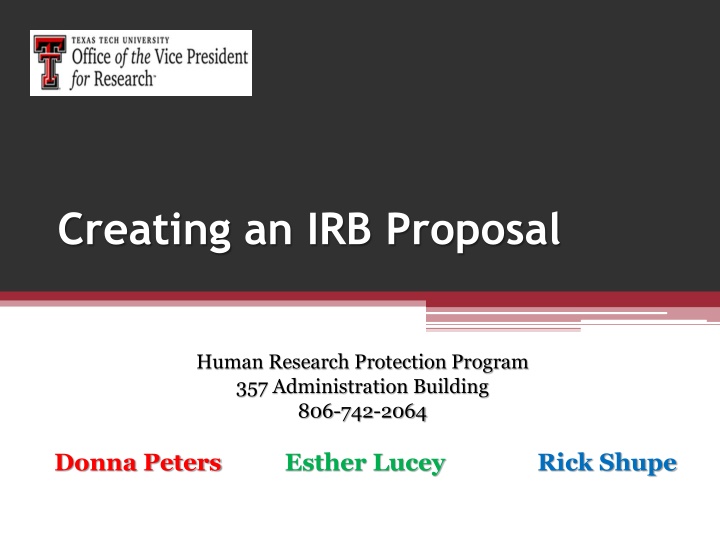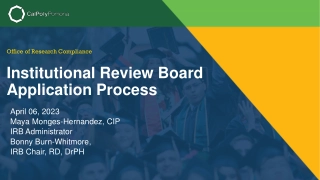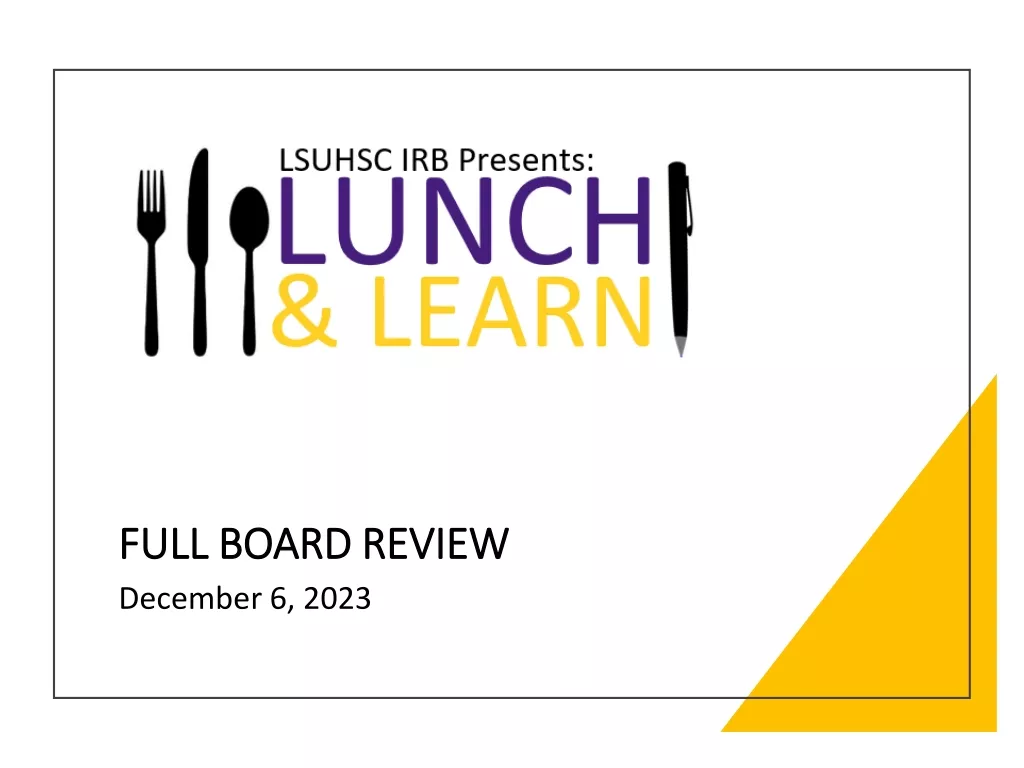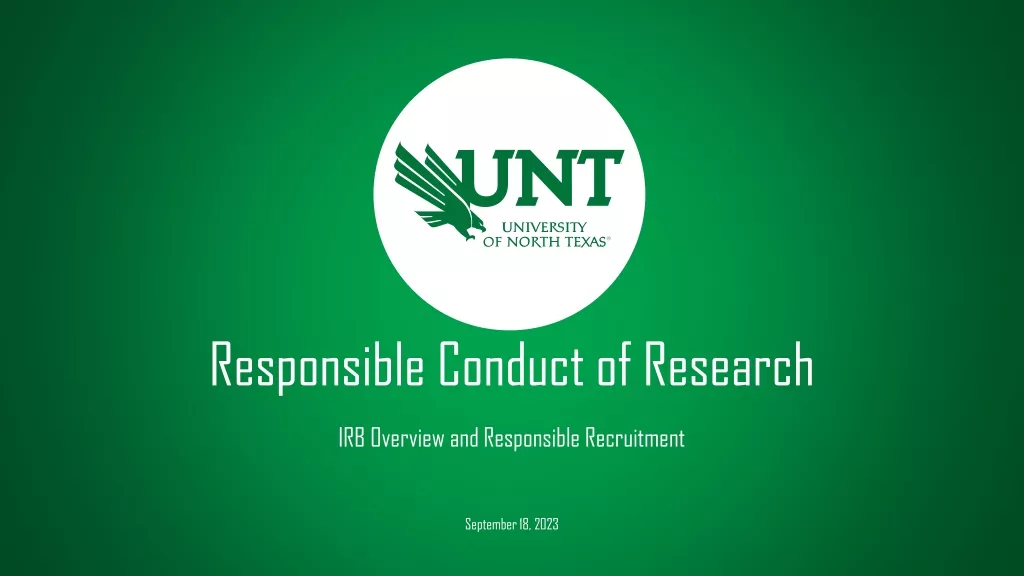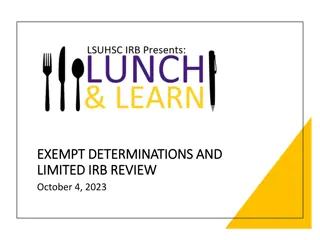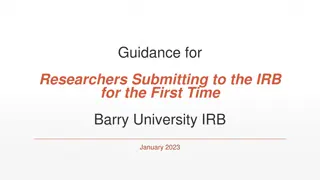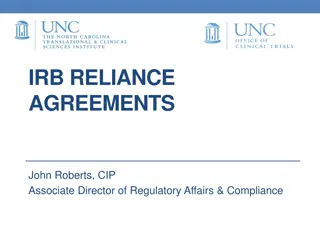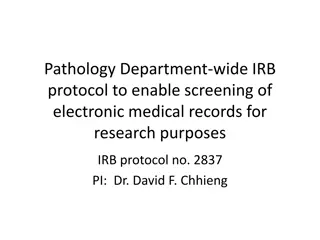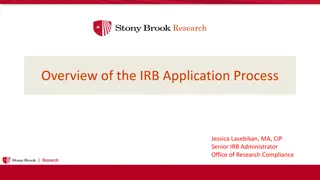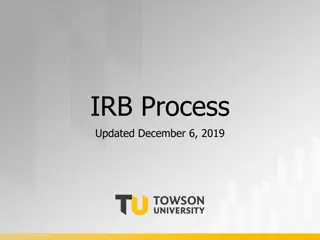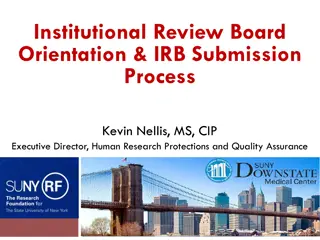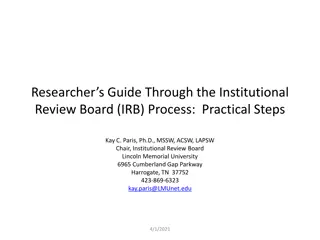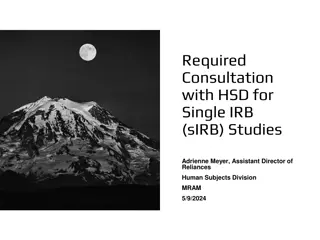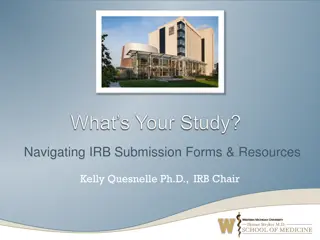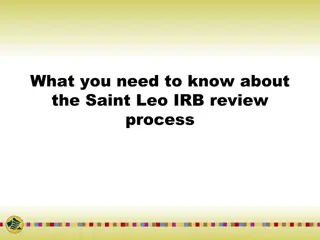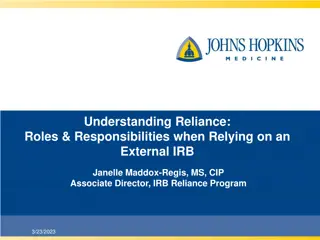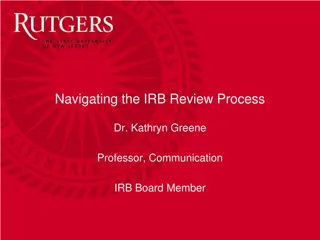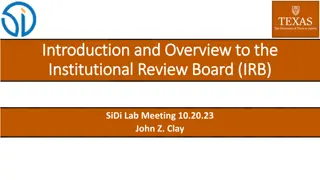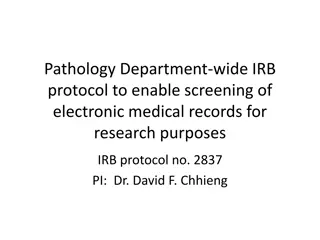IRB Proposal Levels of Review
The IRB proposal levels of review outline the categories for assessing human subjects research, including exempt, expedited, and full board review. These levels determine the extent of risk to participants and the required review process for different types of studies. Understanding these levels is essential for researchers engaging in human subject research to ensure ethical protocols are followed and participant safety is upheld.
Download Presentation

Please find below an Image/Link to download the presentation.
The content on the website is provided AS IS for your information and personal use only. It may not be sold, licensed, or shared on other websites without obtaining consent from the author.If you encounter any issues during the download, it is possible that the publisher has removed the file from their server.
You are allowed to download the files provided on this website for personal or commercial use, subject to the condition that they are used lawfully. All files are the property of their respective owners.
The content on the website is provided AS IS for your information and personal use only. It may not be sold, licensed, or shared on other websites without obtaining consent from the author.
E N D
Presentation Transcript
Creating an IRB Proposal Human Research Protection Program 357 Administration Building 806-742-2064 Donna Peters Esther Lucey Rick Shupe
The Belmont Report The guiding principles behind human subjects research Respect for persons (Consent) informed enough to make a decision to participate? Beneficence (Risk/Benefit Assessment) what are the risks? the benefits? Justice (Selection of Subjects) people must be treated equally and fairly
Proposal Levels of Review Exempt: An IRB review category that does not require annual renewal, poses no more than minimal risk to human subjects, and usually involves anonymous data (no identifiable information) Examples Teaching strategies Surveys Taste testing and food quality Program evaluations
Proposal Levels of Review Expedited Review - An IRB category that involves no more than minimal risk but may include identifiers and data that needs to be protected and kept confidential Examples Children (2 reviewers) Focus groups Blood draws Collection of data from voice, video, digital or image recordings
Proposal Levels of Review Full Board Review: An IRB category that involves a higher degree of potential risk to human subjects Examples Genetics (identifiable information, future use) Medical procedures Vulnerable populations Prisoners Exercise and sports activity
HRPP Website www.hrpp.ttu.edu Guidance Training Proposals
The Cover Sheet Standard for every submission Proposal Title List the PI and C0-investigators Requires signatures Department information Type of Review Determines other forms required Special Populations Funding (Sponsored) Can be filled out online
Expedited Review Form Please Underline
The Proposal The heading should include: The name of the PI The name(s) of the co-investigators The title of the research proposal Follow the format sequence Use Roman numerals Insert page numbers Submit single-sided only Do not use staples
The Rationale Describe: The problem or purpose of the research; The present knowledge relevant to the problem (cite your sources in the body); The aims of the proposed study; Clearly state the potential benefits of the work to the subjects involved; and, The importance of the knowledge to be obtained. Rationale narrative should be at least 2-3 paragraphs but no more 2-3 pages.
II. Subjects Describe the target population (i.e., Pregnant mothers with children under 3 years of age, TTU students, faculty/staff, etc.) Provide a specific age range if all ages are not included and explain Describe any exclusions (i.e., non-English speaking, females only, etc.) and explain why other groups are not being used (Belmont - Justice) Describe the recruitment procedure What media will be used to recruit (TechAnnounce, social networks, TV/radio ads, SONA, organizational websites, fliers, emailings etc.) Include copies of each recruiting document (www.hrpp.ttu.edu) Information sheet/Consent form (Belmont Respect) consent forms are not used for Exempt reviews Each document should be a separately labeled attachment (i.e., Attachment A TechAnnounce Ad; Attachment B Recruiting Email; Attachment C Information Sheet, etc.) and placed in order of the chronological steps in section III. Procedures Example The participants for this study are persons considered successful small business owners in towns with populations between 15,000 and 35,000 in eastern Arizona. Names, phone numbers and email addresses of potential participants for this study will be compiled through information taken from public industry websites.
III. Procedures This section should be a step-by-step, chronological sequence (beginning with recruitment) of the manner and order you will conduct your research and the Attachments/Appendices should follow that specific order. Cite the attachments in the body of this section. Identify and assess any risks (physical, psychological, social, legal, and economic) to participants. (Belmont Beneficence) If there are no risks, clearly state. If there are risks, include any precautions that will be taken to avoid negative outcomes. If there are risks, provide an estimate of their frequency, severity, and reversibility. How is the risk to vulnerable populations (infants, fetuses, pregnant mothers, prisoners, children) being minimized? How are privacy and confidentiality being protected? Where is the data being stored and who has access to it? Describe any benefits and/or compensation to the subjects. Include the amount of time participation will take.
IV. Adverse Events and Liability If the risk to subjects is more than minimal, specify the steps to deal with unexpected, adverse events. If risk to subjects is more than minimal, specify arrangements for handling liability of unexpected injuries (physical, psychological, social, legal, and economic). If no liability plan is offered, state such. NOTE: If the research includes no more than minimal risk and no liability plan is offered, insert, The research does not pose any more than minimal risk to the participant beyond that of everyday life and therefore no liability plan is offered. NOTE: Any adverse events, unanticipated problems, injuries or deviations from the protocol MUST be reported to the HRPP immediately (TTU IRB 5.3).
V. Consent Forms Consent forms are not required for exempt reviews. If the review is Exempt enter N/A (an information sheet would commonly be attached). If the review is Expedited or Full Board enter See Attachment C. Attach a consent form covering all the relevant elements of informed consent (See HRPP website for the template). There are circumstances that exist where consent may be waived. In such cases, attach the blank Waiver of Written Consent form.
Beyond the Proposal Format Page Reference Page Attachments or Appendices arranged in order per III. Procedures and labeled accordingly. Recruiting Documentation (use templates) Oral Scripts Are you recruiting live? Ads TechAnnounce, newspaper, TV, radio Internet Social media, organization websites Fliers Emails, written communication Information Sheet Consent Form(s) Assent Forms Surveys, interview questions, etc.
Recruiting Human Subjects Incentive and Rewards Subjects are reimbursed for their time; not paid for their participation Coercion and Undue Influence Coercion occurs when an overt or implicit threat of harm is intentionally presented by one person to another in order to obtain compliance. (An instructor recruiting members of his/her own class for research). Undue influence often occurs through an offer of an excessive or inappropriate reward or other overture in order to obtain compliance. (Example: $150.00 for filling out a simple 5 minute questionnaire)
Forms and Examples
Forms and Examples
IRB Review Process Researchers (Principal Investigators) send proposals to the HRPP office (in person, Tech mail, email). Typically a 3-5 day administrative process before the proposal is assigned and sent to an IRB reviewer. (NOTE: During peak months and semester breaks the process may take longer.) Letter of acknowledgement to PI Assigned a number Scanned into the HRPP tracking system Pre-screened by HRPP to cut down on reviewer time (NOTE: The amount of time it takes to forward for review depends on how long it takes the PI to submit the revisions) Once assigned the proposal, the IRB Reviewer has a minimum of 1 0 working days to begin the review process. There is no IRB review time limit once the review process begins. All is dependent on communication and revisions between reviewer and PI. Most revisions are handled by email. Approval is granted by the IRB Reviewer and commonly the PI told they can begin collecting data. A formal approval letter is sent to the researcher(s) by email.
Research Understanding The primary concern of the IRB is the protection of human subjects in research. The HRPP/IRB does not and will not dictate how you conduct your research. Your success is our success.
Contact Information Esther Lucey Program Coordinator esther.lucey@ttu.edu Rick Shupe Program Coordinator rick.shupe@ttu.edu Donna Peters HRPP Manager donna.peters@ttu.edu 357 Administration Building 742-2064 hrpp@ttu.edu
Bye now. Yall come back. Thank you And Good Luck!
